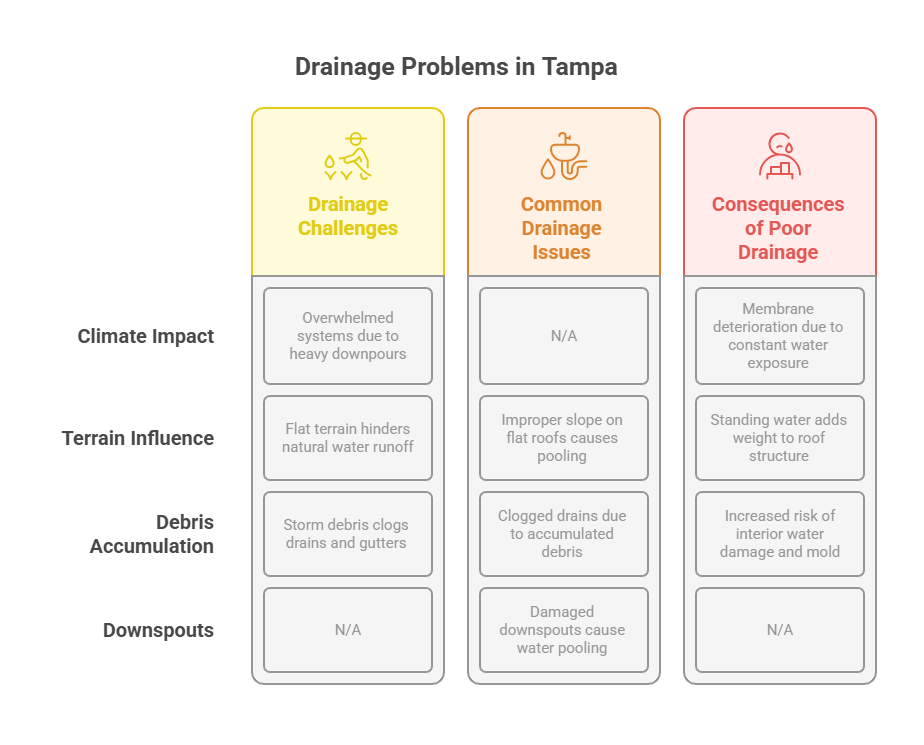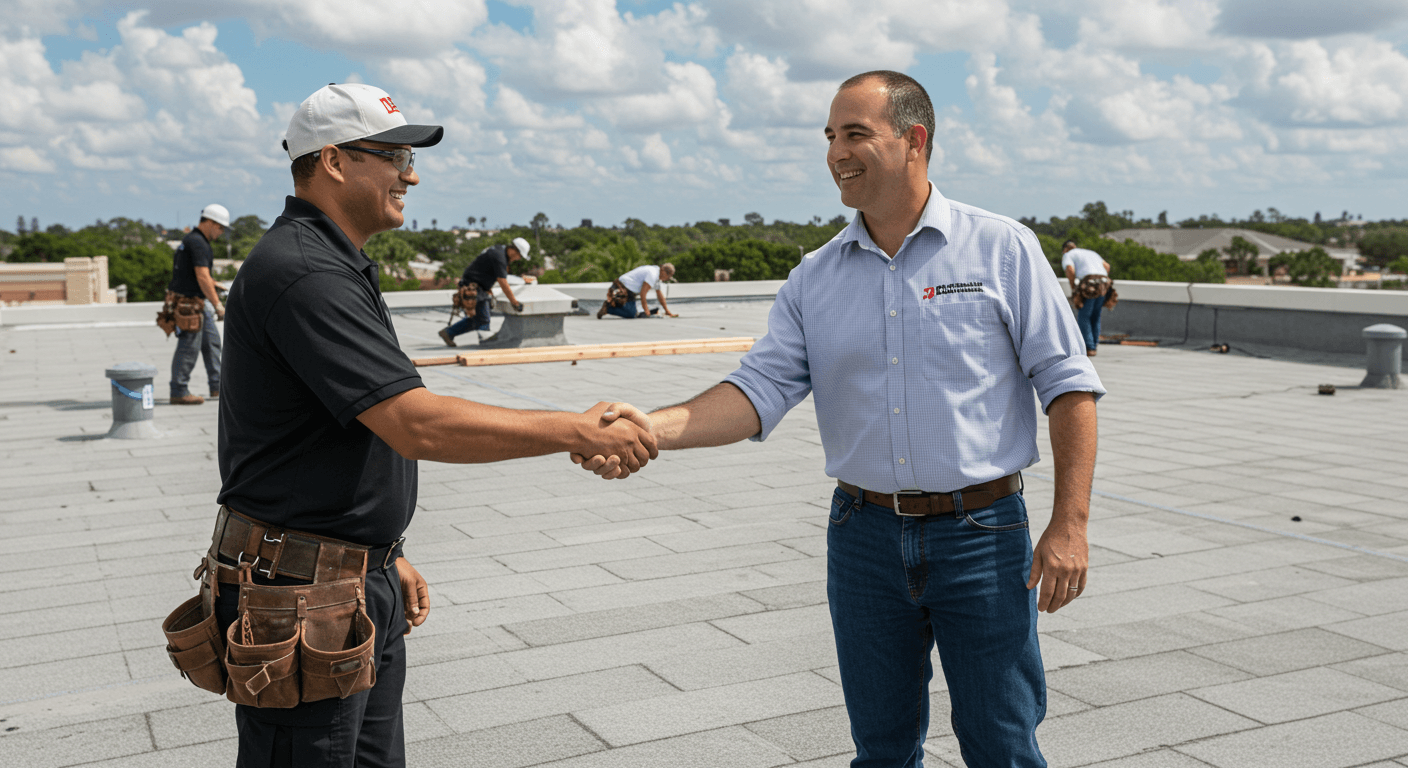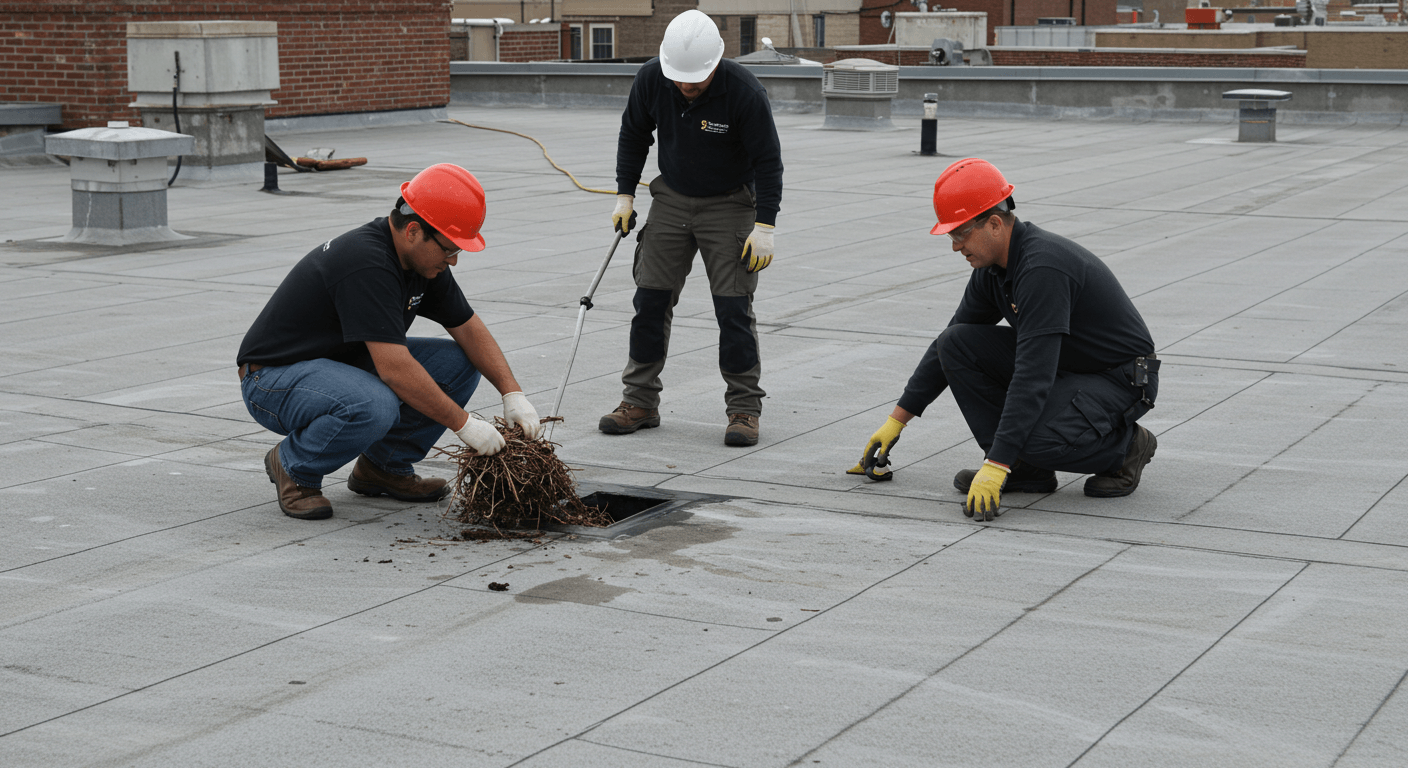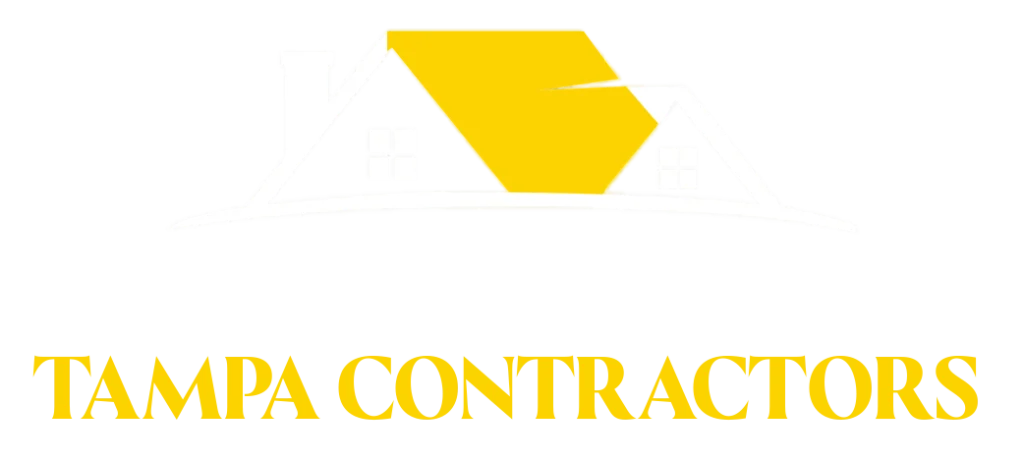As a Tampa business owner, your commercial roof faces some of the toughest weather conditions in the country. From intense summer heat and UV rays to sudden thunderstorms and hurricane threats, Florida’s climate can take a serious toll on your building’s most important protection system.
The key to avoiding costly emergency repairs and potential business interruptions is catching roof problems early. Many commercial roof issues start small but can quickly turn into major headaches if left untreated. Understanding the warning signs can save you thousands of dollars and protect your business from unexpected downtime.
Let’s explore the five most critical signs that your Tampa commercial roof needs professional attention, so you can take action before minor issues become major disasters.
Sign #1 – Visible Water Damage or Active Leaks
Interior Water Damage Indicators

Water damage is often the first sign most business owners notice, and unfortunately, by the time you see it inside your building, the problem has likely been developing for weeks or months. Look for ceiling stains, discoloration, or dark spots that seem to appear or grow after rainstorms.
Peeling paint or wallpaper near the ceiling edges can also indicate water infiltration. These areas often start small but expand over time as moisture continues to seep through your roof system. Don’t ignore even minor discoloration – what looks like a small problem on the surface often represents much larger issues above your ceiling.
Musty odors are another red flag that shouldn’t be overlooked. When water gets into your building materials, it creates the perfect environment for mold and mildew growth. This not only damages your property but can also create health concerns for employees and customers.
Roof Surface Water Issues
On flat commercial roofs, standing water is a serious concern. Tampa’s heavy rainfall can overwhelm inadequate drainage systems, causing water to pool on your roof surface. This ponding water adds extra weight to your roof structure and accelerates membrane deterioration.
After Tampa’s frequent afternoon thunderstorms, take a look at your roof if it’s safely accessible. Water should drain away within 24-48 hours. If you consistently see standing water days after rainfall, your drainage system needs attention.
Clogged drains and gutters are common culprits behind water problems. Leaves, debris, and even small animals can block drainage systems, causing water to back up and find alternative paths into your building.
Why Tampa Climate Makes This Critical
Tampa’s climate makes water issues particularly dangerous for commercial buildings. The combination of heavy rainfall and high humidity means that once moisture gets into your building materials, it doesn’t dry out easily. This creates ideal conditions for mold growth and structural damage.
During hurricane season, even minor roof leaks can become major problems when faced with driving rain and strong winds. Water that might normally stay outside can be forced through small openings that wouldn’t normally be a concern.
Immediate Action Required
If you notice any signs of water damage, don’t wait to address them. Document the damage with photos for insurance purposes, and get professional commercial roof leak repair help immediately. Quick action can often prevent a small repair from becoming a major roof replacement project.
For active leaks during storms, place buckets or tarps to protect your interior, but don’t attempt roof repairs during dangerous weather conditions. Focus on minimizing interior damage until professional help can safely address the source of the problem.
Sign #2 – Membrane Damage and Surface Deterioration
Common Membrane Problems in Tampa
Tampa’s intense heat and UV exposure can cause significant damage to commercial roofing membranes over time. TPO and EPDM systems, while durable, can develop problems that compromise their protective abilities.
Seam separation is one of the most common issues on membrane roofs. The constant expansion and contraction from Tampa’s daily temperature swings can stress the seams where membrane sections connect. Look for gaps or separations along these joints, especially after extreme weather events.
Punctures from debris are another frequent problem. Tampa’s storms can send tree branches, roof gravel, and other objects flying onto your roof surface. Even small punctures can allow water infiltration and lead to larger problems if not repaired promptly.
Shrinkage is particularly common in Florida’s climate. As membranes age and are exposed to heat cycles, they can actually shrink and pull away from edges, penetrations, and attachment points. This creates gaps where water can enter your building.
Visual Inspection Checklist
Regular visual inspections can help you catch membrane problems early. Look for cracking or splitting in the membrane surface, which often appears as dark lines or gaps in the material. These cracks typically start small but can expand rapidly under stress.
Bubbling or blistering on the membrane surface indicates that moisture has gotten trapped underneath the roofing material. These bubbles can break open and create direct pathways for water to enter your building.
Pay attention to areas around roof penetrations like vents, HVAC units, and skylights. These are common spots for membrane damage because they experience more movement and stress than flat roof areas.
UV Damage in Florida Climate
Florida’s intense UV radiation can break down roofing materials faster than in other climates. Even UV-resistant membranes will eventually show signs of degradation after years of exposure to Tampa’s strong sunshine.
Look for changes in your membrane’s color or texture. Fading, chalking, or brittleness can indicate UV damage that’s compromising your roof’s protective abilities. These changes often happen gradually, so regular inspections help track deterioration over time.
Reflective coatings on your roof may also degrade over time, reducing their energy efficiency benefits. If your once-bright white roof has turned gray or dingy, it may be time for recoating or replacement.
Assessment and Documentation
When you notice membrane damage, document it thoroughly with photos and notes about the location and extent of the problems. This information helps contractors provide accurate estimates and can be valuable for insurance claims.
Don’t attempt to repair membrane damage yourself unless you have proper training and equipment. Professional commercial roof repair services ensure proper materials and techniques are used to prevent future problems.
Sign #3 – Structural Issues and Sagging
Identifying Structural Problems
Structural issues with your commercial roof are serious safety concerns that require immediate professional attention. Visible sagging or dips in your roof surface indicate that the underlying structure may be compromised.
Look for areas where the roof line doesn’t appear straight or level. Even small depressions can indicate problems with roof decking, support beams, or the building’s structural framework. These issues often develop gradually but can reach critical points quickly.
Cracked or damaged roof decking is another warning sign of structural problems. If you can access your roof safely, look for areas where the surface feels soft or spongy underfoot, which may indicate rot or deterioration in the decking material.
Settlement or shifting in your building’s foundation can also affect your roof structure. Cracks in walls, doors that don’t close properly, or windows that stick can all be signs of building movement that’s stressing your roof system.
Safety Concerns
Structural roof problems create serious safety risks for anyone in your building. A compromised roof system may not be able to handle normal loads, let alone additional weight from equipment, snow, or hurricane-force winds.
Employee and customer safety should be your top priority if you suspect structural issues. Consider restricting access to areas below suspected problem zones until professional evaluation can determine the extent of any structural damage.
Insurance and liability concerns also make structural issues critical to address promptly. If someone is injured due to a roof collapse or falling debris, you could face significant legal and financial consequences.
Professional Structural Assessment
Structural roof problems require evaluation by qualified professionals, often including structural engineers in addition to roofing contractors. These experts can determine whether issues are cosmetic or represent serious safety hazards.
Load calculations may be necessary to determine if your roof can safely support existing equipment and expected loads. This is particularly important for older buildings that may have had equipment added over the years.
The decision between repair and replacement depends on the extent of structural damage and the cost-effectiveness of different solutions. Sometimes extensive repairs cost more than replacement while providing less long-term value.
Sign #4 – Drainage and Gutter Problems

Tampa’s Drainage Challenges
Tampa’s climate presents unique drainage challenges for commercial buildings. The area’s frequent heavy downpours can overwhelm inadequate drainage systems, while the flat terrain means water doesn’t naturally run off quickly.
Tropical storms and hurricanes bring additional debris that can clog drains and gutters. Palm fronds, branches, and other vegetation commonly block drainage systems during and after storms, creating backup problems when you need drainage most.
Even during normal weather, Tampa’s high humidity and frequent rainfall mean your drainage system works harder than in drier climates. Systems that might be adequate elsewhere may be insufficient for Florida’s weather patterns.
Common Drainage Issues
Clogged drains are the most frequent drainage problem on commercial roofs. Leaves, dirt, and debris accumulate in drains over time, reducing their capacity and eventually blocking them completely. Regular cleaning is essential but often overlooked.
Damaged or disconnected downspouts can cause water to pool around your building’s foundation instead of draining away properly. This can lead to foundation problems and basement flooding in addition to roof issues.
Improper slope on flat roofs is another common problem. Commercial roofs need adequate slope to direct water toward drains, but settling, poor installation, or added equipment can create low spots where water collects.
Consequences of Poor Drainage
Poor drainage accelerates membrane deterioration by keeping water in contact with your roofing materials longer than intended. This constant exposure breaks down protective coatings and can lead to premature roof failure.
Standing water also adds significant weight to your roof structure. A single inch of water across a large roof area can add thousands of pounds of load that your building wasn’t designed to support long-term.
Drainage problems increase the risk of interior water damage and mold growth. Even if water doesn’t leak through your roof immediately, poor drainage creates conditions that make future leaks more likely and more severe.
Sign #5 – Rising Energy Costs and HVAC Strain
Roof’s Impact on Energy Efficiency
Your commercial roof plays a crucial role in your building’s energy efficiency, especially in Tampa’s hot climate. When your roof system isn’t performing properly, your HVAC system has to work harder to maintain comfortable temperatures.
Insulation compromise from moisture infiltration can significantly reduce your roof’s thermal performance. Even small amounts of water can reduce insulation effectiveness by 50% or more, leading to much higher cooling costs.
Air leakage through roof penetrations, damaged membranes, or poor sealing allows conditioned air to escape and hot, humid outside air to enter your building. This puts additional strain on your HVAC system and increases energy consumption.
Lost reflectivity from dirty, damaged, or deteriorated roof surfaces means your roof absorbs more heat instead of reflecting it away. This is particularly problematic in Tampa, where roof surface temperatures can exceed 150 degrees on summer days.
Warning Signs of Energy Loss
Unexplained increases in your utility bills, especially during Tampa’s hot summer months, can indicate roof-related energy loss. Compare your current bills to previous years to identify unusual patterns or increases.
Uneven building temperatures or difficulty maintaining comfortable conditions may indicate that your roof system isn’t providing adequate thermal protection. Hot spots in your building often correspond to problem areas on your roof.
If your HVAC system seems to run constantly or cycles on and off frequently, it may be working harder than necessary due to roof-related energy loss. This not only increases energy costs but also accelerates wear on your HVAC equipment.
Professional Energy Assessment
Thermal imaging inspections can identify areas where your roof is losing energy efficiency. These specialized cameras can detect temperature differences that indicate insulation problems, air leaks, or other energy-related issues.
Professional energy audits can help quantify the impact of roof problems on your energy costs and identify the most cost-effective solutions. Sometimes roof repairs or improvements can pay for themselves through energy savings.
Consider the long-term costs of energy loss when evaluating repair versus replacement options. A roof system that’s causing high energy costs may be more expensive to keep than to replace, even if it’s not yet failing completely.
Taking Action: When to Call Tampa Commercial Roofers

Emergency vs. Planned Repairs
Some roof problems require immediate attention to prevent safety hazards or major damage. Active leaks, structural issues, or severe storm damage should be addressed as emergencies, even if temporary solutions are needed until permanent repairs can be completed.
Storm-related damage is particularly common in Tampa and requires prompt professional assessment. If your roof has been damaged by high winds, hail, or flying debris, specialized commercial storm damage repair services can help restore your roof’s protective capabilities quickly.
Other issues, like gradual membrane deterioration or minor drainage problems, can be addressed through planned maintenance and repairs. However, don’t delay these repairs too long – minor problems can quickly become major ones in Tampa’s aggressive climate.
Weather-related damage after storms requires prompt attention to prevent further deterioration. Even if damage seems minor, Tampa’s frequent rainfall means that small problems can quickly worsen if not properly sealed.
Choosing the Right Contractor
When roof problems arise, choosing the right contractor is crucial for getting lasting solutions. Look for contractors with specific experience in commercial roofing and proven track records in Tampa’s climate conditions.
Verify that any contractor you consider is properly licensed and insured for commercial work in Florida. Ask for references from other Tampa businesses and check their Better Business Bureau ratings.
Emergency response capabilities are important for Tampa businesses due to the area’s severe weather potential. Choose contractors who offer 24/7 emergency services and have the equipment and staff to respond quickly when needed.
Preventive Maintenance Benefits

Regular professional inspections can catch problems before they become expensive emergencies. Most roofing contractors recommend bi-annual inspections, typically in spring and fall, plus additional inspections after severe weather events.
A professional commercial roof inspection can identify potential issues and help you plan for necessary repairs before they become urgent. This proactive approach often saves money and prevents business disruptions.
Preventive maintenance programs can extend your roof’s lifespan and maintain warranty coverage. Many manufacturers require regular professional maintenance to keep warranties valid, making these programs valuable investments.
Small repairs completed promptly cost much less than major repairs or emergency replacements. Addressing minor issues during scheduled maintenance prevents them from developing into serious problems that require urgent attention.
Protecting Your Tampa Business Investment
Your commercial roof is one of your most important business assets, and Tampa’s challenging climate makes proper maintenance even more critical. The five warning signs we’ve discussed – water damage, membrane deterioration, structural issues, drainage problems, and energy loss – can all lead to serious problems if ignored.
Don’t wait until you’re dealing with emergency repairs or business interruptions. Regular inspections and prompt attention to warning signs can save you thousands of dollars and protect your business operations from weather-related disruptions.
If you’ve noticed any of these warning signs in your Tampa commercial building, it’s time to take action. Whether you need comprehensive repair services or are planning proactive maintenance, working with experienced professionals ensures your roof continues protecting your business investment.
Remember that roof problems rarely improve on their own, especially in Tampa’s aggressive climate. The sooner you address issues, the more options you’ll have for cost-effective solutions.
Ready to ensure your commercial roof is properly protecting your Tampa business? Contact our experienced team for a comprehensive evaluation of your roof system. We can help you identify potential problems and develop a maintenance plan that keeps your roof performing at its best for years to come.
Don’t let roof problems catch you off guard. Take a proactive approach to roof maintenance and enjoy the peace of mind that comes with knowing your Tampa business is properly protected from whatever weather comes your way.
